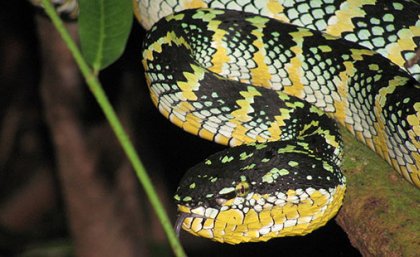Developing Animal-Free Neurotoxin Testing
The need to assess a group of deadly neurotoxins without turning to animal-testing may soon be a possibility. A new animal-free testing technique was recently developed for paralytic neurotoxins by researchers at the University of Queensland. The technique will replace old conventional methods that often required the euthanasia of test subjects.
A temple pit viper from Gombak Valley, Malaysia (Credit: Scientistchic via University of Queensland).
"The old method, while extremely efficient, is limited in that it's slow and requires the euthanisation of animals in order to obtain the necessary tissue," says Associate Professor Bryan Fry, of UQ's Venom Evolution Lab. "Our new method uses optical probes dipped into a solution containing the venoms and we measure the binding to these probes -- the critical factor -- by analysing changes in the light reflected back. It's going to reduce the numbers of animals used for research testing, but it also has significant biomedical implications."
Examining paralytic neurotoxins is not just for research into anti-venoms, but testing these neurotoxins is often need for treating a broad spectrum of diseases and conditions.
"The team can now -- without the use of animal subjects -- screen venoms for non-target activities that may be relevant for drug design and development, helping treat all types of ailments," Dr Fry said. "For example, we've showed that temple pit viper venom has an unusual cross-reactivity for the human alpha-5 receptor, which is a major target for conditions including colitis and smoking. Who knows what other potential treatments the world's venoms could lead to -- we're excited to find out."
The technique depends on the production of synthetic peptides that attach to nerve receptors and allow muscles to contract.
"Neurotoxins, found in the venom of many types of snakes, cause paralysis by attaching to nerve receptors in our muscles, preventing the normal chemical binding process that naturally occurs in our bodies when we want to move," Dr. Fry said. "This is what stops a mouse fleeing from a snake after it has been bitten.
Learn more on why snake venom is so deadly:
"Since venoms bind to the synthetic peptides more vigorously than they do to human nerves, we're also investigating a new treatment of snakebite, using these peptides as 'decoys'”, adds Dr. Fry. "The venom would bind to them instead of their original nervous system target in the human body. Many species of deadly snake lack an effective anti-venom, so these sorts of applications may help meet this critical need.”
Source: The University of Queensland









